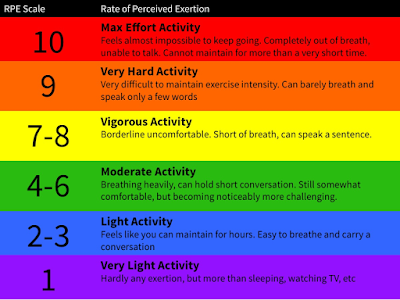It’s important first to get familiar with the numbers, especially if you don’t have a heart rate monitor. It can be used for anyone from beginning to advanced fitness levels.
- 1 on the RPE Scale is equivalent to you sitting on the couch or laying down.
- 10 on the RPE Scale is equivalent to maximal effort – sprinting up a steep hill or pushing a heavy sled
According to recommended exercise guidelines we should be getting at least 30 to 45 minutes of moderately – intense exercises five days per week. Moderate intensity exercise translates to a 4 or 5 on the RPE scale, while vigorous activity can land on the RPE scale with a range of 6 to 8.
How do you Measure RPE when exercising?
Before you begin exercising, consider how you feel when you are resting in a seated or reclined position, exerting no effort and breathing easily. On the scale, this would rate as a “0”. Then consider a time you were working the hardest you’ve ever worked – this would rate as a “10”. Many activities have images and words on the RPE scale that you can use to help guide you. For example, see the below scales for running, weightlifting, biking, and aerobics.

Throughout your exercise session, continue to monitor how you’re feeling on this sale of 0 -10 every few minutes. This will help you to know if you’re on average performing moderate (RPE 4-6) or vigorous (RPE 6-8) exercise. It’s that easy! When you finish your workout write down what your average RPE was to keep track of how intense your workouts are, and how much physical activity you’re getting each week.
Exercise is important to our overall health and wellness. It’s also important to track the intensity of your workouts and see how you are feeling while doing certain exercises. The RPE Scale is a great way to track your intensity. This allow us to remain in the safe zone as we workout – get started now by tracking your intensity and how you are feeling during your workouts!

